Reflective Essay: MBA401 People, Culture, and Contemporary Leadership
VerifiedAdded on 2023/06/12
|16
|3119
|474
Essay
AI Summary
This reflective essay explores the author's leadership qualities, weaknesses, and development process through the lens of personal experiences during an internship and academic activities. It delves into leadership theories like Path-Goal theory and utilizes personality assessments such as the Myers-Brigg Type Indicator and the Big Five Personality Test to identify strengths and areas for improvement. The essay discusses practical activities undertaken to enhance communication skills, decision-making abilities, and overall leadership effectiveness, emphasizing the importance of self-awareness and continuous development in becoming a successful leader. The author reflects on past experiences and provides insights into the ways to improve leadership skills. Desklib offers similar solved assignments and resources for students.
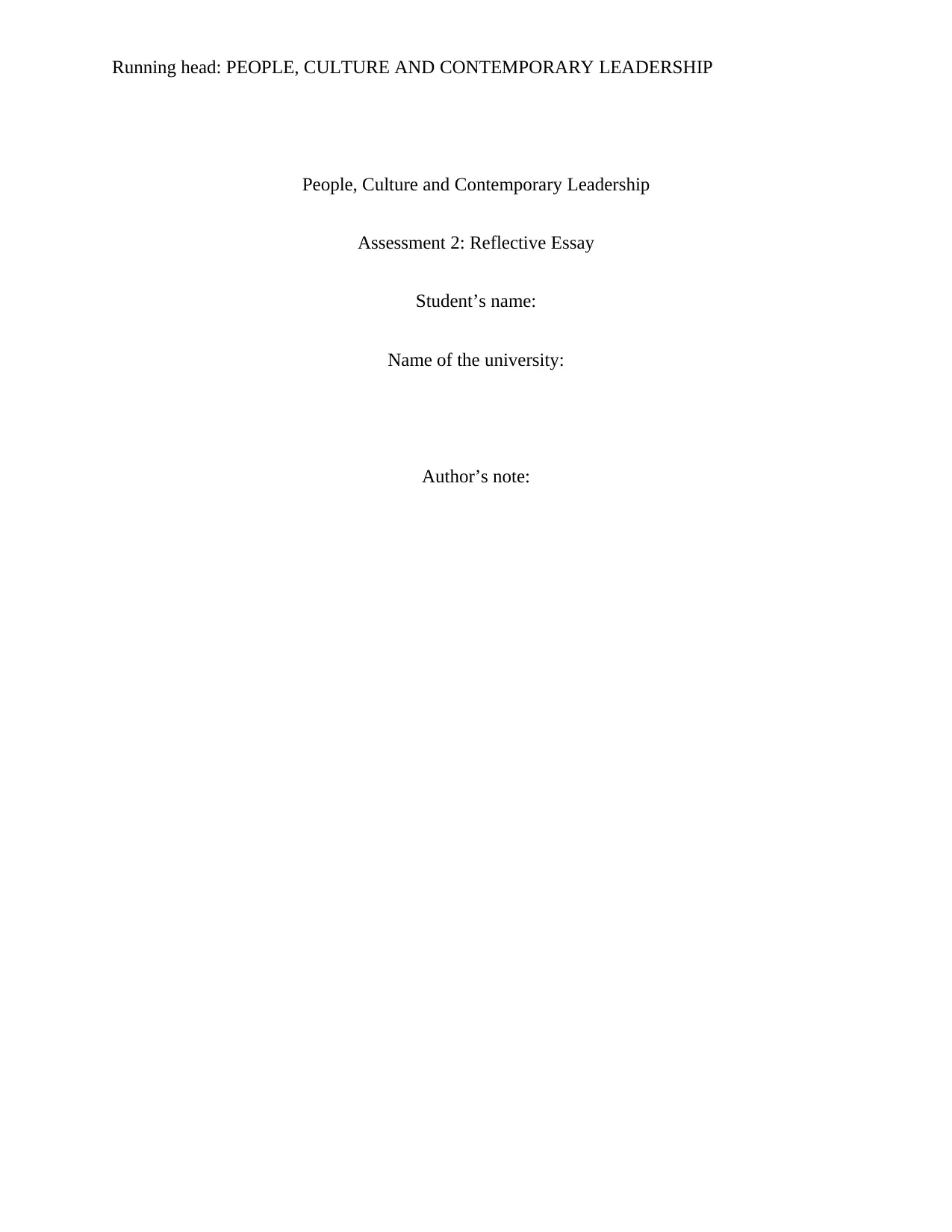
Running head: PEOPLE, CULTURE AND CONTEMPORARY LEADERSHIP
People, Culture and Contemporary Leadership
Assessment 2: Reflective Essay
Student’s name:
Name of the university:
Author’s note:
People, Culture and Contemporary Leadership
Assessment 2: Reflective Essay
Student’s name:
Name of the university:
Author’s note:
Paraphrase This Document
Need a fresh take? Get an instant paraphrase of this document with our AI Paraphraser
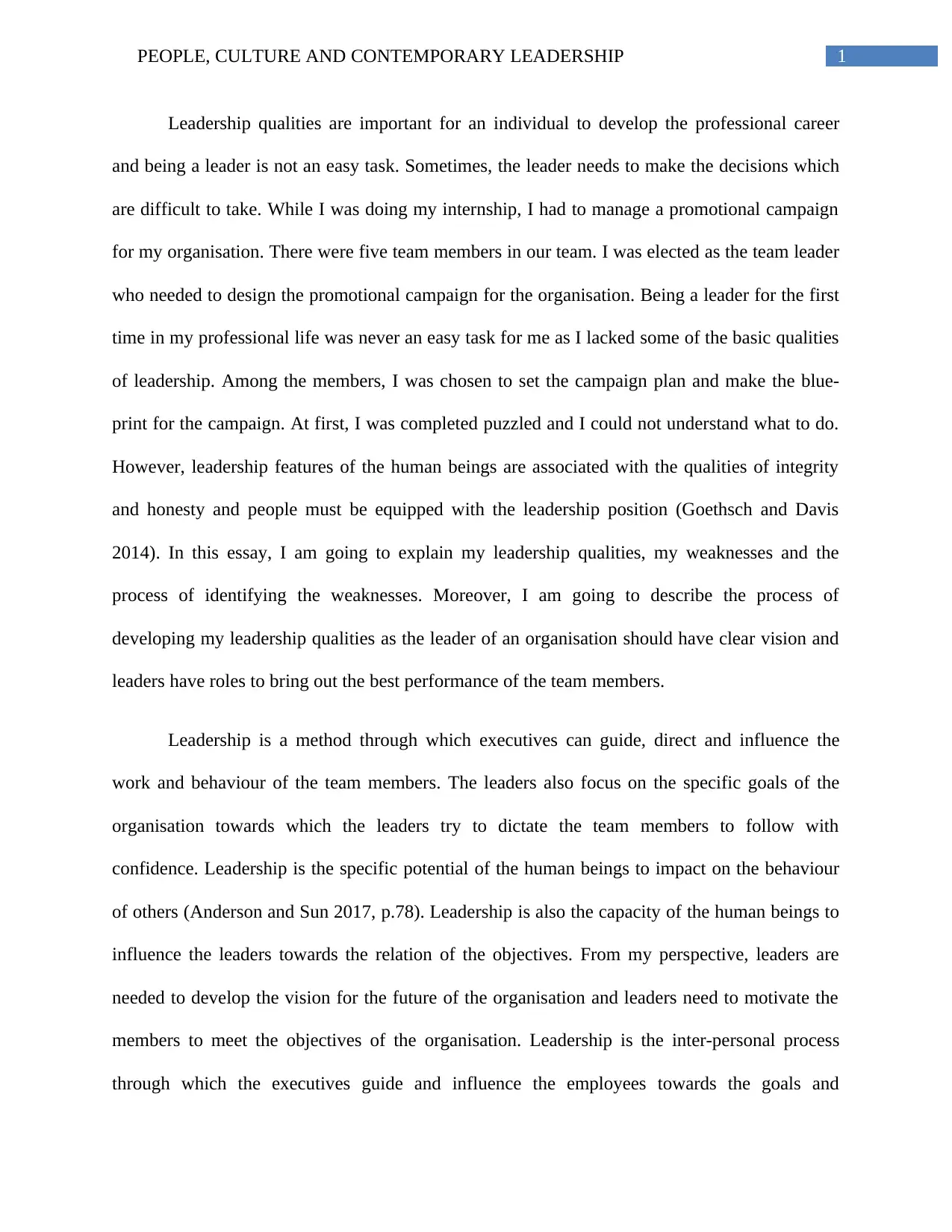
1PEOPLE, CULTURE AND CONTEMPORARY LEADERSHIP
Leadership qualities are important for an individual to develop the professional career
and being a leader is not an easy task. Sometimes, the leader needs to make the decisions which
are difficult to take. While I was doing my internship, I had to manage a promotional campaign
for my organisation. There were five team members in our team. I was elected as the team leader
who needed to design the promotional campaign for the organisation. Being a leader for the first
time in my professional life was never an easy task for me as I lacked some of the basic qualities
of leadership. Among the members, I was chosen to set the campaign plan and make the blue-
print for the campaign. At first, I was completed puzzled and I could not understand what to do.
However, leadership features of the human beings are associated with the qualities of integrity
and honesty and people must be equipped with the leadership position (Goethsch and Davis
2014). In this essay, I am going to explain my leadership qualities, my weaknesses and the
process of identifying the weaknesses. Moreover, I am going to describe the process of
developing my leadership qualities as the leader of an organisation should have clear vision and
leaders have roles to bring out the best performance of the team members.
Leadership is a method through which executives can guide, direct and influence the
work and behaviour of the team members. The leaders also focus on the specific goals of the
organisation towards which the leaders try to dictate the team members to follow with
confidence. Leadership is the specific potential of the human beings to impact on the behaviour
of others (Anderson and Sun 2017, p.78). Leadership is also the capacity of the human beings to
influence the leaders towards the relation of the objectives. From my perspective, leaders are
needed to develop the vision for the future of the organisation and leaders need to motivate the
members to meet the objectives of the organisation. Leadership is the inter-personal process
through which the executives guide and influence the employees towards the goals and
Leadership qualities are important for an individual to develop the professional career
and being a leader is not an easy task. Sometimes, the leader needs to make the decisions which
are difficult to take. While I was doing my internship, I had to manage a promotional campaign
for my organisation. There were five team members in our team. I was elected as the team leader
who needed to design the promotional campaign for the organisation. Being a leader for the first
time in my professional life was never an easy task for me as I lacked some of the basic qualities
of leadership. Among the members, I was chosen to set the campaign plan and make the blue-
print for the campaign. At first, I was completed puzzled and I could not understand what to do.
However, leadership features of the human beings are associated with the qualities of integrity
and honesty and people must be equipped with the leadership position (Goethsch and Davis
2014). In this essay, I am going to explain my leadership qualities, my weaknesses and the
process of identifying the weaknesses. Moreover, I am going to describe the process of
developing my leadership qualities as the leader of an organisation should have clear vision and
leaders have roles to bring out the best performance of the team members.
Leadership is a method through which executives can guide, direct and influence the
work and behaviour of the team members. The leaders also focus on the specific goals of the
organisation towards which the leaders try to dictate the team members to follow with
confidence. Leadership is the specific potential of the human beings to impact on the behaviour
of others (Anderson and Sun 2017, p.78). Leadership is also the capacity of the human beings to
influence the leaders towards the relation of the objectives. From my perspective, leaders are
needed to develop the vision for the future of the organisation and leaders need to motivate the
members to meet the objectives of the organisation. Leadership is the inter-personal process
through which the executives guide and influence the employees towards the goals and
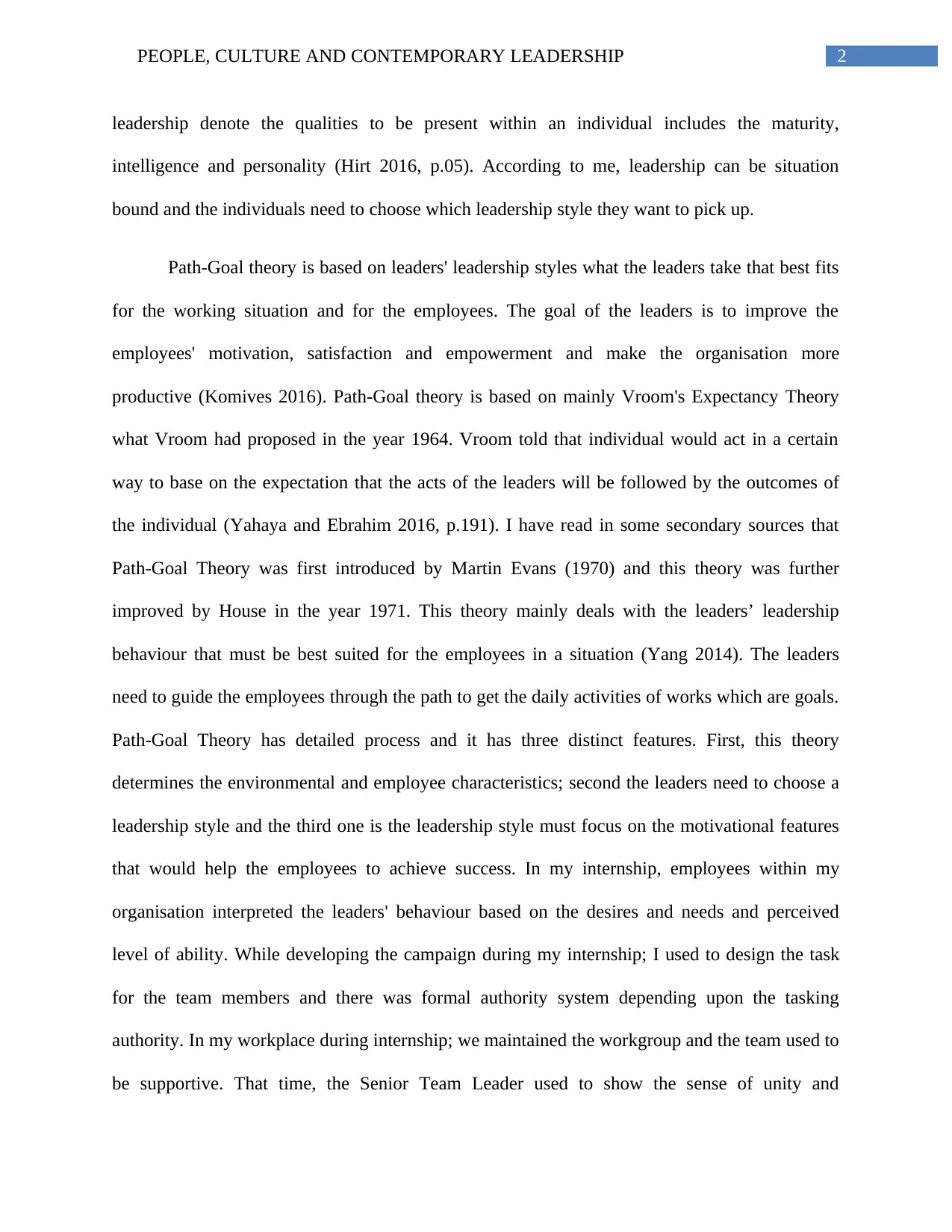
2PEOPLE, CULTURE AND CONTEMPORARY LEADERSHIP
leadership denote the qualities to be present within an individual includes the maturity,
intelligence and personality (Hirt 2016, p.05). According to me, leadership can be situation
bound and the individuals need to choose which leadership style they want to pick up.
Path-Goal theory is based on leaders' leadership styles what the leaders take that best fits
for the working situation and for the employees. The goal of the leaders is to improve the
employees' motivation, satisfaction and empowerment and make the organisation more
productive (Komives 2016). Path-Goal theory is based on mainly Vroom's Expectancy Theory
what Vroom had proposed in the year 1964. Vroom told that individual would act in a certain
way to base on the expectation that the acts of the leaders will be followed by the outcomes of
the individual (Yahaya and Ebrahim 2016, p.191). I have read in some secondary sources that
Path-Goal Theory was first introduced by Martin Evans (1970) and this theory was further
improved by House in the year 1971. This theory mainly deals with the leaders’ leadership
behaviour that must be best suited for the employees in a situation (Yang 2014). The leaders
need to guide the employees through the path to get the daily activities of works which are goals.
Path-Goal Theory has detailed process and it has three distinct features. First, this theory
determines the environmental and employee characteristics; second the leaders need to choose a
leadership style and the third one is the leadership style must focus on the motivational features
that would help the employees to achieve success. In my internship, employees within my
organisation interpreted the leaders' behaviour based on the desires and needs and perceived
level of ability. While developing the campaign during my internship; I used to design the task
for the team members and there was formal authority system depending upon the tasking
authority. In my workplace during internship; we maintained the workgroup and the team used to
be supportive. That time, the Senior Team Leader used to show the sense of unity and
leadership denote the qualities to be present within an individual includes the maturity,
intelligence and personality (Hirt 2016, p.05). According to me, leadership can be situation
bound and the individuals need to choose which leadership style they want to pick up.
Path-Goal theory is based on leaders' leadership styles what the leaders take that best fits
for the working situation and for the employees. The goal of the leaders is to improve the
employees' motivation, satisfaction and empowerment and make the organisation more
productive (Komives 2016). Path-Goal theory is based on mainly Vroom's Expectancy Theory
what Vroom had proposed in the year 1964. Vroom told that individual would act in a certain
way to base on the expectation that the acts of the leaders will be followed by the outcomes of
the individual (Yahaya and Ebrahim 2016, p.191). I have read in some secondary sources that
Path-Goal Theory was first introduced by Martin Evans (1970) and this theory was further
improved by House in the year 1971. This theory mainly deals with the leaders’ leadership
behaviour that must be best suited for the employees in a situation (Yang 2014). The leaders
need to guide the employees through the path to get the daily activities of works which are goals.
Path-Goal Theory has detailed process and it has three distinct features. First, this theory
determines the environmental and employee characteristics; second the leaders need to choose a
leadership style and the third one is the leadership style must focus on the motivational features
that would help the employees to achieve success. In my internship, employees within my
organisation interpreted the leaders' behaviour based on the desires and needs and perceived
level of ability. While developing the campaign during my internship; I used to design the task
for the team members and there was formal authority system depending upon the tasking
authority. In my workplace during internship; we maintained the workgroup and the team used to
be supportive. That time, the Senior Team Leader used to show the sense of unity and
⊘ This is a preview!⊘
Do you want full access?
Subscribe today to unlock all pages.

Trusted by 1+ million students worldwide
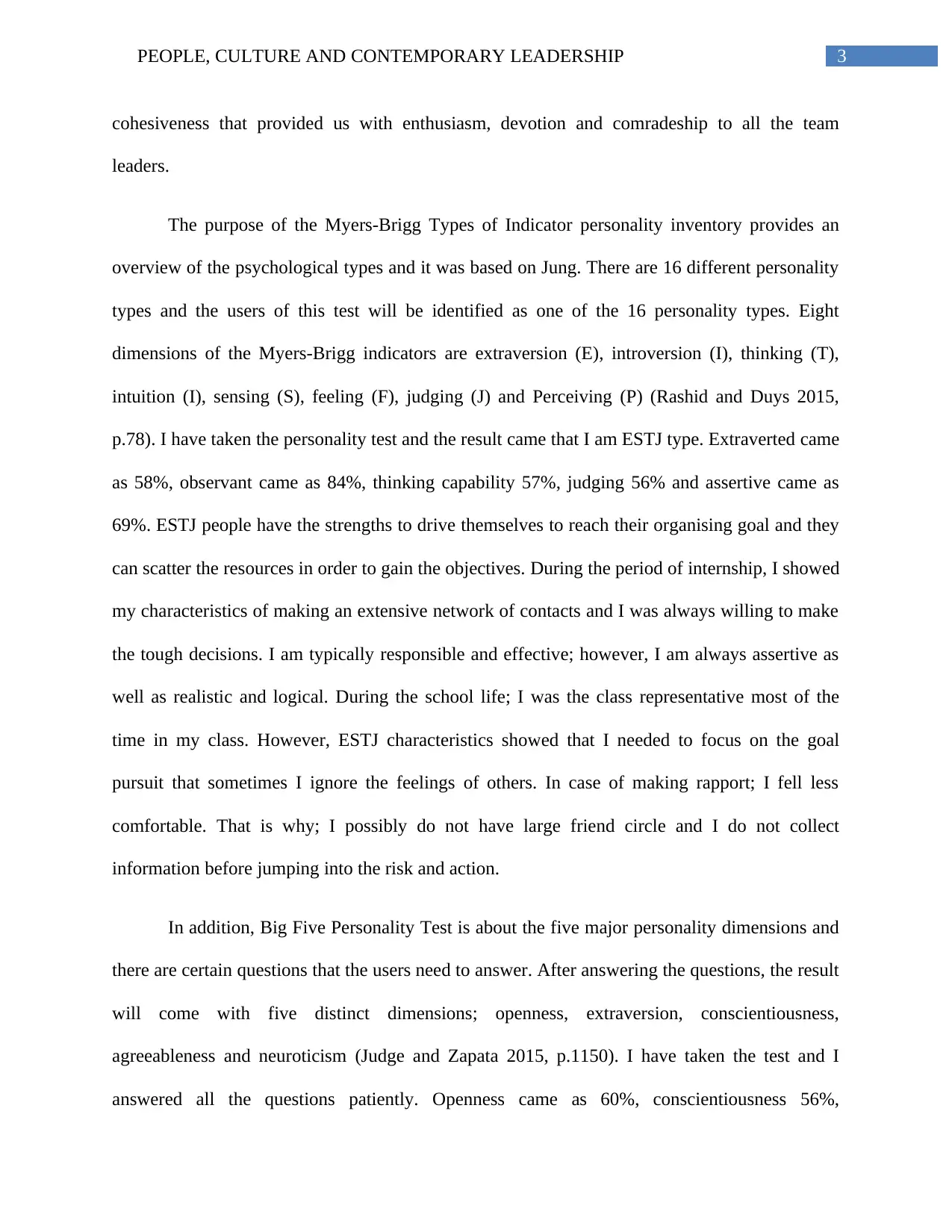
3PEOPLE, CULTURE AND CONTEMPORARY LEADERSHIP
cohesiveness that provided us with enthusiasm, devotion and comradeship to all the team
leaders.
The purpose of the Myers-Brigg Types of Indicator personality inventory provides an
overview of the psychological types and it was based on Jung. There are 16 different personality
types and the users of this test will be identified as one of the 16 personality types. Eight
dimensions of the Myers-Brigg indicators are extraversion (E), introversion (I), thinking (T),
intuition (I), sensing (S), feeling (F), judging (J) and Perceiving (P) (Rashid and Duys 2015,
p.78). I have taken the personality test and the result came that I am ESTJ type. Extraverted came
as 58%, observant came as 84%, thinking capability 57%, judging 56% and assertive came as
69%. ESTJ people have the strengths to drive themselves to reach their organising goal and they
can scatter the resources in order to gain the objectives. During the period of internship, I showed
my characteristics of making an extensive network of contacts and I was always willing to make
the tough decisions. I am typically responsible and effective; however, I am always assertive as
well as realistic and logical. During the school life; I was the class representative most of the
time in my class. However, ESTJ characteristics showed that I needed to focus on the goal
pursuit that sometimes I ignore the feelings of others. In case of making rapport; I fell less
comfortable. That is why; I possibly do not have large friend circle and I do not collect
information before jumping into the risk and action.
In addition, Big Five Personality Test is about the five major personality dimensions and
there are certain questions that the users need to answer. After answering the questions, the result
will come with five distinct dimensions; openness, extraversion, conscientiousness,
agreeableness and neuroticism (Judge and Zapata 2015, p.1150). I have taken the test and I
answered all the questions patiently. Openness came as 60%, conscientiousness 56%,
cohesiveness that provided us with enthusiasm, devotion and comradeship to all the team
leaders.
The purpose of the Myers-Brigg Types of Indicator personality inventory provides an
overview of the psychological types and it was based on Jung. There are 16 different personality
types and the users of this test will be identified as one of the 16 personality types. Eight
dimensions of the Myers-Brigg indicators are extraversion (E), introversion (I), thinking (T),
intuition (I), sensing (S), feeling (F), judging (J) and Perceiving (P) (Rashid and Duys 2015,
p.78). I have taken the personality test and the result came that I am ESTJ type. Extraverted came
as 58%, observant came as 84%, thinking capability 57%, judging 56% and assertive came as
69%. ESTJ people have the strengths to drive themselves to reach their organising goal and they
can scatter the resources in order to gain the objectives. During the period of internship, I showed
my characteristics of making an extensive network of contacts and I was always willing to make
the tough decisions. I am typically responsible and effective; however, I am always assertive as
well as realistic and logical. During the school life; I was the class representative most of the
time in my class. However, ESTJ characteristics showed that I needed to focus on the goal
pursuit that sometimes I ignore the feelings of others. In case of making rapport; I fell less
comfortable. That is why; I possibly do not have large friend circle and I do not collect
information before jumping into the risk and action.
In addition, Big Five Personality Test is about the five major personality dimensions and
there are certain questions that the users need to answer. After answering the questions, the result
will come with five distinct dimensions; openness, extraversion, conscientiousness,
agreeableness and neuroticism (Judge and Zapata 2015, p.1150). I have taken the test and I
answered all the questions patiently. Openness came as 60%, conscientiousness 56%,
Paraphrase This Document
Need a fresh take? Get an instant paraphrase of this document with our AI Paraphraser
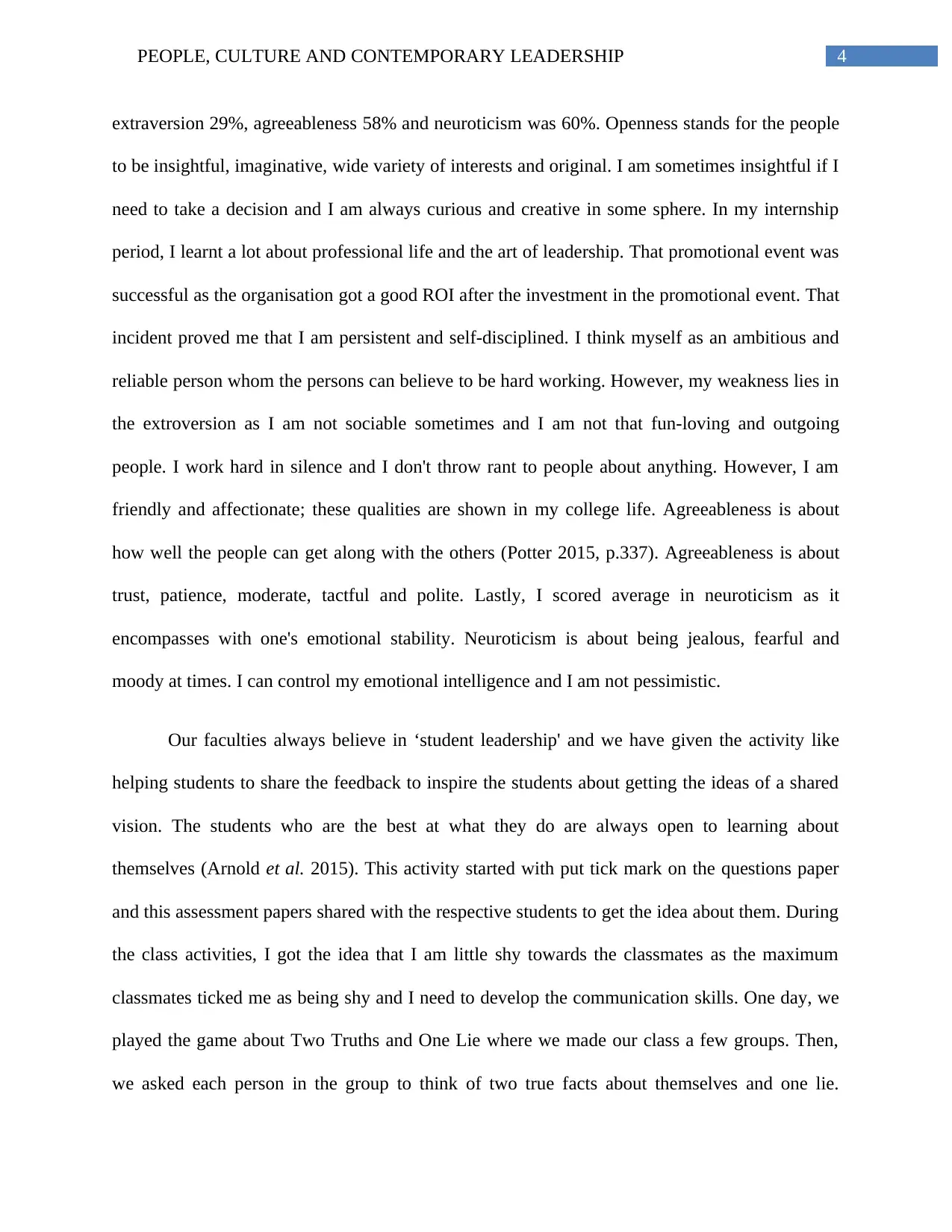
4PEOPLE, CULTURE AND CONTEMPORARY LEADERSHIP
extraversion 29%, agreeableness 58% and neuroticism was 60%. Openness stands for the people
to be insightful, imaginative, wide variety of interests and original. I am sometimes insightful if I
need to take a decision and I am always curious and creative in some sphere. In my internship
period, I learnt a lot about professional life and the art of leadership. That promotional event was
successful as the organisation got a good ROI after the investment in the promotional event. That
incident proved me that I am persistent and self-disciplined. I think myself as an ambitious and
reliable person whom the persons can believe to be hard working. However, my weakness lies in
the extroversion as I am not sociable sometimes and I am not that fun-loving and outgoing
people. I work hard in silence and I don't throw rant to people about anything. However, I am
friendly and affectionate; these qualities are shown in my college life. Agreeableness is about
how well the people can get along with the others (Potter 2015, p.337). Agreeableness is about
trust, patience, moderate, tactful and polite. Lastly, I scored average in neuroticism as it
encompasses with one's emotional stability. Neuroticism is about being jealous, fearful and
moody at times. I can control my emotional intelligence and I am not pessimistic.
Our faculties always believe in ‘student leadership' and we have given the activity like
helping students to share the feedback to inspire the students about getting the ideas of a shared
vision. The students who are the best at what they do are always open to learning about
themselves (Arnold et al. 2015). This activity started with put tick mark on the questions paper
and this assessment papers shared with the respective students to get the idea about them. During
the class activities, I got the idea that I am little shy towards the classmates as the maximum
classmates ticked me as being shy and I need to develop the communication skills. One day, we
played the game about Two Truths and One Lie where we made our class a few groups. Then,
we asked each person in the group to think of two true facts about themselves and one lie.
extraversion 29%, agreeableness 58% and neuroticism was 60%. Openness stands for the people
to be insightful, imaginative, wide variety of interests and original. I am sometimes insightful if I
need to take a decision and I am always curious and creative in some sphere. In my internship
period, I learnt a lot about professional life and the art of leadership. That promotional event was
successful as the organisation got a good ROI after the investment in the promotional event. That
incident proved me that I am persistent and self-disciplined. I think myself as an ambitious and
reliable person whom the persons can believe to be hard working. However, my weakness lies in
the extroversion as I am not sociable sometimes and I am not that fun-loving and outgoing
people. I work hard in silence and I don't throw rant to people about anything. However, I am
friendly and affectionate; these qualities are shown in my college life. Agreeableness is about
how well the people can get along with the others (Potter 2015, p.337). Agreeableness is about
trust, patience, moderate, tactful and polite. Lastly, I scored average in neuroticism as it
encompasses with one's emotional stability. Neuroticism is about being jealous, fearful and
moody at times. I can control my emotional intelligence and I am not pessimistic.
Our faculties always believe in ‘student leadership' and we have given the activity like
helping students to share the feedback to inspire the students about getting the ideas of a shared
vision. The students who are the best at what they do are always open to learning about
themselves (Arnold et al. 2015). This activity started with put tick mark on the questions paper
and this assessment papers shared with the respective students to get the idea about them. During
the class activities, I got the idea that I am little shy towards the classmates as the maximum
classmates ticked me as being shy and I need to develop the communication skills. One day, we
played the game about Two Truths and One Lie where we made our class a few groups. Then,
we asked each person in the group to think of two true facts about themselves and one lie.
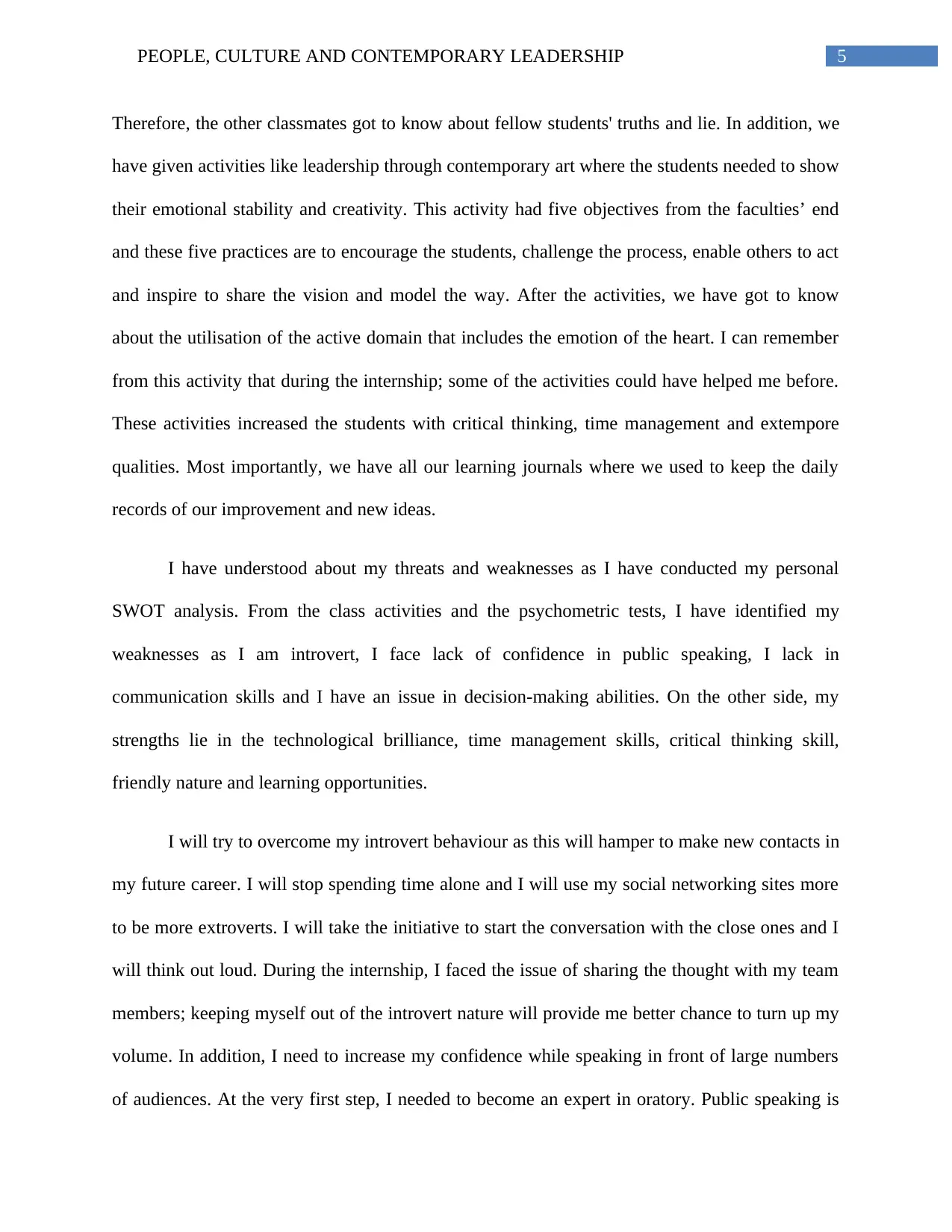
5PEOPLE, CULTURE AND CONTEMPORARY LEADERSHIP
Therefore, the other classmates got to know about fellow students' truths and lie. In addition, we
have given activities like leadership through contemporary art where the students needed to show
their emotional stability and creativity. This activity had five objectives from the faculties’ end
and these five practices are to encourage the students, challenge the process, enable others to act
and inspire to share the vision and model the way. After the activities, we have got to know
about the utilisation of the active domain that includes the emotion of the heart. I can remember
from this activity that during the internship; some of the activities could have helped me before.
These activities increased the students with critical thinking, time management and extempore
qualities. Most importantly, we have all our learning journals where we used to keep the daily
records of our improvement and new ideas.
I have understood about my threats and weaknesses as I have conducted my personal
SWOT analysis. From the class activities and the psychometric tests, I have identified my
weaknesses as I am introvert, I face lack of confidence in public speaking, I lack in
communication skills and I have an issue in decision-making abilities. On the other side, my
strengths lie in the technological brilliance, time management skills, critical thinking skill,
friendly nature and learning opportunities.
I will try to overcome my introvert behaviour as this will hamper to make new contacts in
my future career. I will stop spending time alone and I will use my social networking sites more
to be more extroverts. I will take the initiative to start the conversation with the close ones and I
will think out loud. During the internship, I faced the issue of sharing the thought with my team
members; keeping myself out of the introvert nature will provide me better chance to turn up my
volume. In addition, I need to increase my confidence while speaking in front of large numbers
of audiences. At the very first step, I needed to become an expert in oratory. Public speaking is
Therefore, the other classmates got to know about fellow students' truths and lie. In addition, we
have given activities like leadership through contemporary art where the students needed to show
their emotional stability and creativity. This activity had five objectives from the faculties’ end
and these five practices are to encourage the students, challenge the process, enable others to act
and inspire to share the vision and model the way. After the activities, we have got to know
about the utilisation of the active domain that includes the emotion of the heart. I can remember
from this activity that during the internship; some of the activities could have helped me before.
These activities increased the students with critical thinking, time management and extempore
qualities. Most importantly, we have all our learning journals where we used to keep the daily
records of our improvement and new ideas.
I have understood about my threats and weaknesses as I have conducted my personal
SWOT analysis. From the class activities and the psychometric tests, I have identified my
weaknesses as I am introvert, I face lack of confidence in public speaking, I lack in
communication skills and I have an issue in decision-making abilities. On the other side, my
strengths lie in the technological brilliance, time management skills, critical thinking skill,
friendly nature and learning opportunities.
I will try to overcome my introvert behaviour as this will hamper to make new contacts in
my future career. I will stop spending time alone and I will use my social networking sites more
to be more extroverts. I will take the initiative to start the conversation with the close ones and I
will think out loud. During the internship, I faced the issue of sharing the thought with my team
members; keeping myself out of the introvert nature will provide me better chance to turn up my
volume. In addition, I need to increase my confidence while speaking in front of large numbers
of audiences. At the very first step, I needed to become an expert in oratory. Public speaking is
⊘ This is a preview!⊘
Do you want full access?
Subscribe today to unlock all pages.

Trusted by 1+ million students worldwide
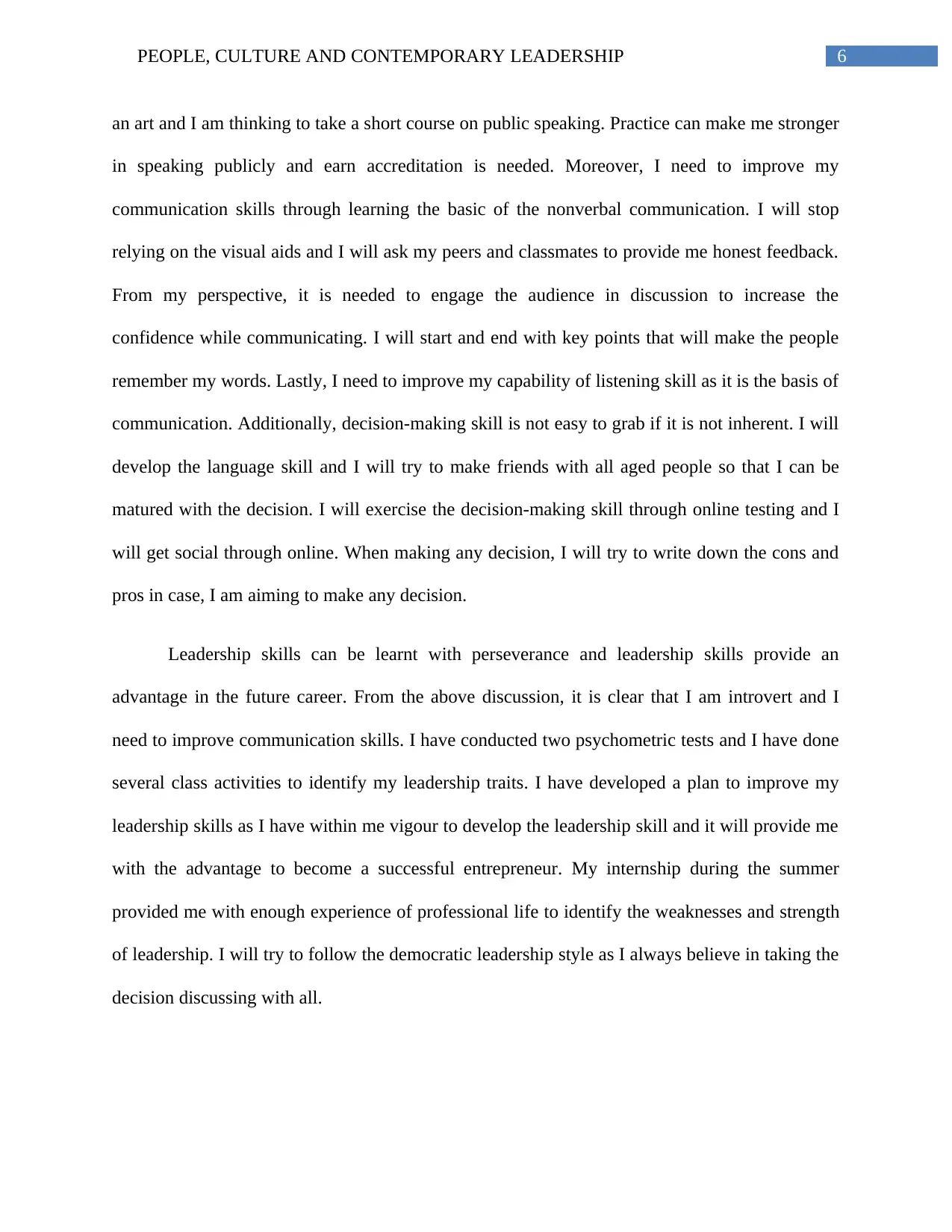
6PEOPLE, CULTURE AND CONTEMPORARY LEADERSHIP
an art and I am thinking to take a short course on public speaking. Practice can make me stronger
in speaking publicly and earn accreditation is needed. Moreover, I need to improve my
communication skills through learning the basic of the nonverbal communication. I will stop
relying on the visual aids and I will ask my peers and classmates to provide me honest feedback.
From my perspective, it is needed to engage the audience in discussion to increase the
confidence while communicating. I will start and end with key points that will make the people
remember my words. Lastly, I need to improve my capability of listening skill as it is the basis of
communication. Additionally, decision-making skill is not easy to grab if it is not inherent. I will
develop the language skill and I will try to make friends with all aged people so that I can be
matured with the decision. I will exercise the decision-making skill through online testing and I
will get social through online. When making any decision, I will try to write down the cons and
pros in case, I am aiming to make any decision.
Leadership skills can be learnt with perseverance and leadership skills provide an
advantage in the future career. From the above discussion, it is clear that I am introvert and I
need to improve communication skills. I have conducted two psychometric tests and I have done
several class activities to identify my leadership traits. I have developed a plan to improve my
leadership skills as I have within me vigour to develop the leadership skill and it will provide me
with the advantage to become a successful entrepreneur. My internship during the summer
provided me with enough experience of professional life to identify the weaknesses and strength
of leadership. I will try to follow the democratic leadership style as I always believe in taking the
decision discussing with all.
an art and I am thinking to take a short course on public speaking. Practice can make me stronger
in speaking publicly and earn accreditation is needed. Moreover, I need to improve my
communication skills through learning the basic of the nonverbal communication. I will stop
relying on the visual aids and I will ask my peers and classmates to provide me honest feedback.
From my perspective, it is needed to engage the audience in discussion to increase the
confidence while communicating. I will start and end with key points that will make the people
remember my words. Lastly, I need to improve my capability of listening skill as it is the basis of
communication. Additionally, decision-making skill is not easy to grab if it is not inherent. I will
develop the language skill and I will try to make friends with all aged people so that I can be
matured with the decision. I will exercise the decision-making skill through online testing and I
will get social through online. When making any decision, I will try to write down the cons and
pros in case, I am aiming to make any decision.
Leadership skills can be learnt with perseverance and leadership skills provide an
advantage in the future career. From the above discussion, it is clear that I am introvert and I
need to improve communication skills. I have conducted two psychometric tests and I have done
several class activities to identify my leadership traits. I have developed a plan to improve my
leadership skills as I have within me vigour to develop the leadership skill and it will provide me
with the advantage to become a successful entrepreneur. My internship during the summer
provided me with enough experience of professional life to identify the weaknesses and strength
of leadership. I will try to follow the democratic leadership style as I always believe in taking the
decision discussing with all.
Paraphrase This Document
Need a fresh take? Get an instant paraphrase of this document with our AI Paraphraser
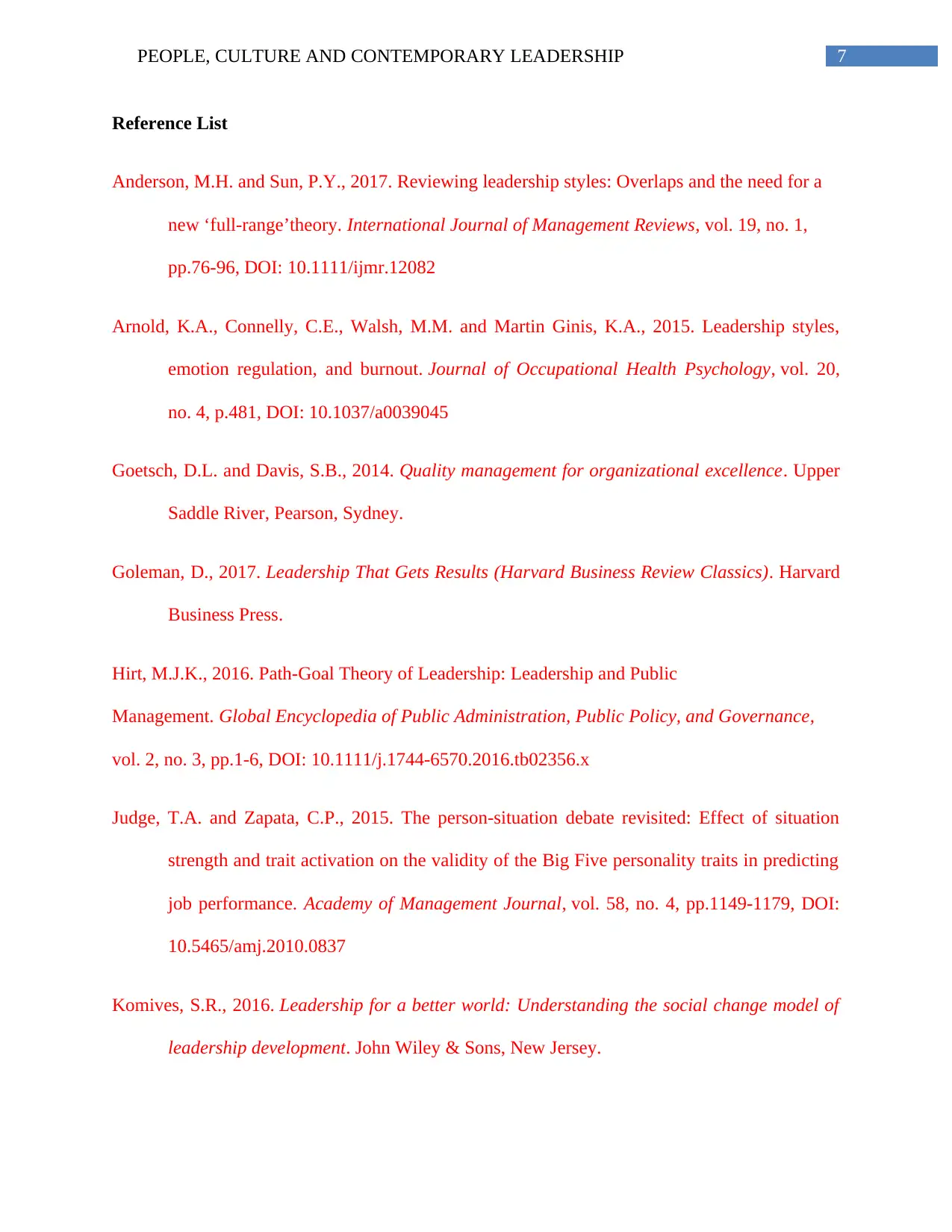
7PEOPLE, CULTURE AND CONTEMPORARY LEADERSHIP
Reference List
Anderson, M.H. and Sun, P.Y., 2017. Reviewing leadership styles: Overlaps and the need for a
new ‘full‐range’theory. International Journal of Management Reviews, vol. 19, no. 1,
pp.76-96, DOI: 10.1111/ijmr.12082
Arnold, K.A., Connelly, C.E., Walsh, M.M. and Martin Ginis, K.A., 2015. Leadership styles,
emotion regulation, and burnout. Journal of Occupational Health Psychology, vol. 20,
no. 4, p.481, DOI: 10.1037/a0039045
Goetsch, D.L. and Davis, S.B., 2014. Quality management for organizational excellence. Upper
Saddle River, Pearson, Sydney.
Goleman, D., 2017. Leadership That Gets Results (Harvard Business Review Classics). Harvard
Business Press.
Hirt, M.J.K., 2016. Path-Goal Theory of Leadership: Leadership and Public
Management. Global Encyclopedia of Public Administration, Public Policy, and Governance,
vol. 2, no. 3, pp.1-6, DOI: 10.1111/j.1744-6570.2016.tb02356.x
Judge, T.A. and Zapata, C.P., 2015. The person-situation debate revisited: Effect of situation
strength and trait activation on the validity of the Big Five personality traits in predicting
job performance. Academy of Management Journal, vol. 58, no. 4, pp.1149-1179, DOI:
10.5465/amj.2010.0837
Komives, S.R., 2016. Leadership for a better world: Understanding the social change model of
leadership development. John Wiley & Sons, New Jersey.
Reference List
Anderson, M.H. and Sun, P.Y., 2017. Reviewing leadership styles: Overlaps and the need for a
new ‘full‐range’theory. International Journal of Management Reviews, vol. 19, no. 1,
pp.76-96, DOI: 10.1111/ijmr.12082
Arnold, K.A., Connelly, C.E., Walsh, M.M. and Martin Ginis, K.A., 2015. Leadership styles,
emotion regulation, and burnout. Journal of Occupational Health Psychology, vol. 20,
no. 4, p.481, DOI: 10.1037/a0039045
Goetsch, D.L. and Davis, S.B., 2014. Quality management for organizational excellence. Upper
Saddle River, Pearson, Sydney.
Goleman, D., 2017. Leadership That Gets Results (Harvard Business Review Classics). Harvard
Business Press.
Hirt, M.J.K., 2016. Path-Goal Theory of Leadership: Leadership and Public
Management. Global Encyclopedia of Public Administration, Public Policy, and Governance,
vol. 2, no. 3, pp.1-6, DOI: 10.1111/j.1744-6570.2016.tb02356.x
Judge, T.A. and Zapata, C.P., 2015. The person-situation debate revisited: Effect of situation
strength and trait activation on the validity of the Big Five personality traits in predicting
job performance. Academy of Management Journal, vol. 58, no. 4, pp.1149-1179, DOI:
10.5465/amj.2010.0837
Komives, S.R., 2016. Leadership for a better world: Understanding the social change model of
leadership development. John Wiley & Sons, New Jersey.
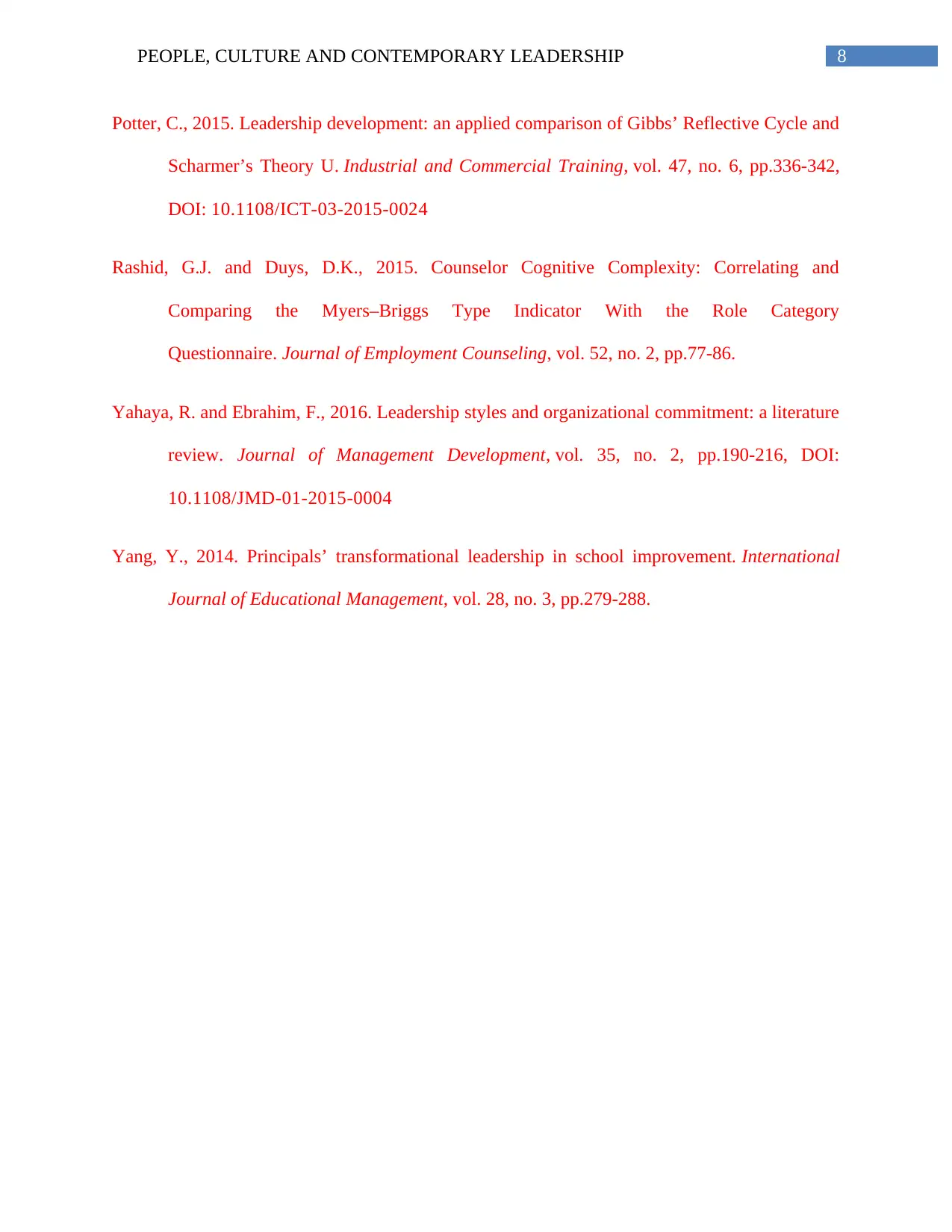
8PEOPLE, CULTURE AND CONTEMPORARY LEADERSHIP
Potter, C., 2015. Leadership development: an applied comparison of Gibbs’ Reflective Cycle and
Scharmer’s Theory U. Industrial and Commercial Training, vol. 47, no. 6, pp.336-342,
DOI: 10.1108/ICT-03-2015-0024
Rashid, G.J. and Duys, D.K., 2015. Counselor Cognitive Complexity: Correlating and
Comparing the Myers–Briggs Type Indicator With the Role Category
Questionnaire. Journal of Employment Counseling, vol. 52, no. 2, pp.77-86.
Yahaya, R. and Ebrahim, F., 2016. Leadership styles and organizational commitment: a literature
review. Journal of Management Development, vol. 35, no. 2, pp.190-216, DOI:
10.1108/JMD-01-2015-0004
Yang, Y., 2014. Principals’ transformational leadership in school improvement. International
Journal of Educational Management, vol. 28, no. 3, pp.279-288.
Potter, C., 2015. Leadership development: an applied comparison of Gibbs’ Reflective Cycle and
Scharmer’s Theory U. Industrial and Commercial Training, vol. 47, no. 6, pp.336-342,
DOI: 10.1108/ICT-03-2015-0024
Rashid, G.J. and Duys, D.K., 2015. Counselor Cognitive Complexity: Correlating and
Comparing the Myers–Briggs Type Indicator With the Role Category
Questionnaire. Journal of Employment Counseling, vol. 52, no. 2, pp.77-86.
Yahaya, R. and Ebrahim, F., 2016. Leadership styles and organizational commitment: a literature
review. Journal of Management Development, vol. 35, no. 2, pp.190-216, DOI:
10.1108/JMD-01-2015-0004
Yang, Y., 2014. Principals’ transformational leadership in school improvement. International
Journal of Educational Management, vol. 28, no. 3, pp.279-288.
⊘ This is a preview!⊘
Do you want full access?
Subscribe today to unlock all pages.

Trusted by 1+ million students worldwide
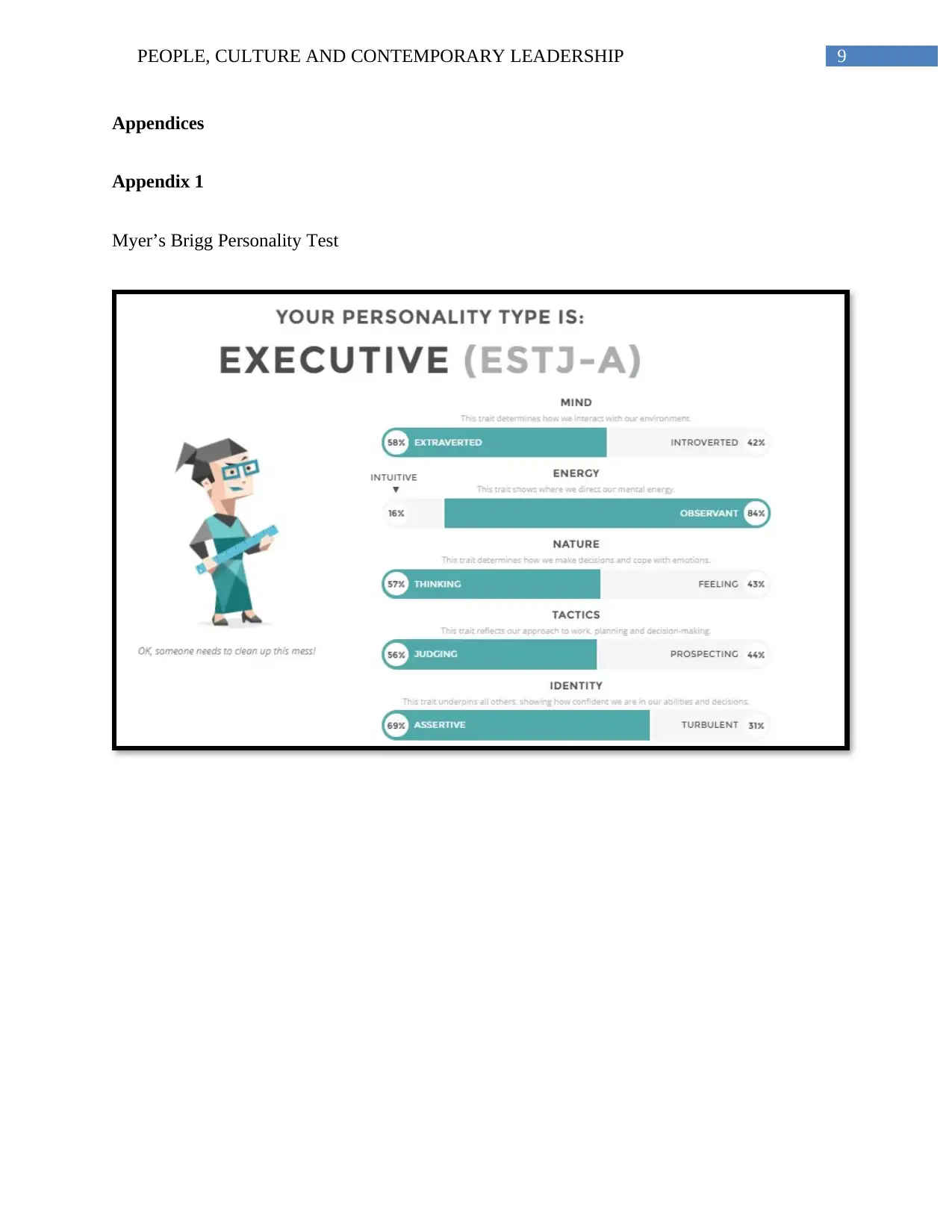
9PEOPLE, CULTURE AND CONTEMPORARY LEADERSHIP
Appendices
Appendix 1
Myer’s Brigg Personality Test
Appendices
Appendix 1
Myer’s Brigg Personality Test
Paraphrase This Document
Need a fresh take? Get an instant paraphrase of this document with our AI Paraphraser

10PEOPLE, CULTURE AND CONTEMPORARY LEADERSHIP
Big Five Personality Test
Big Five Personality Test
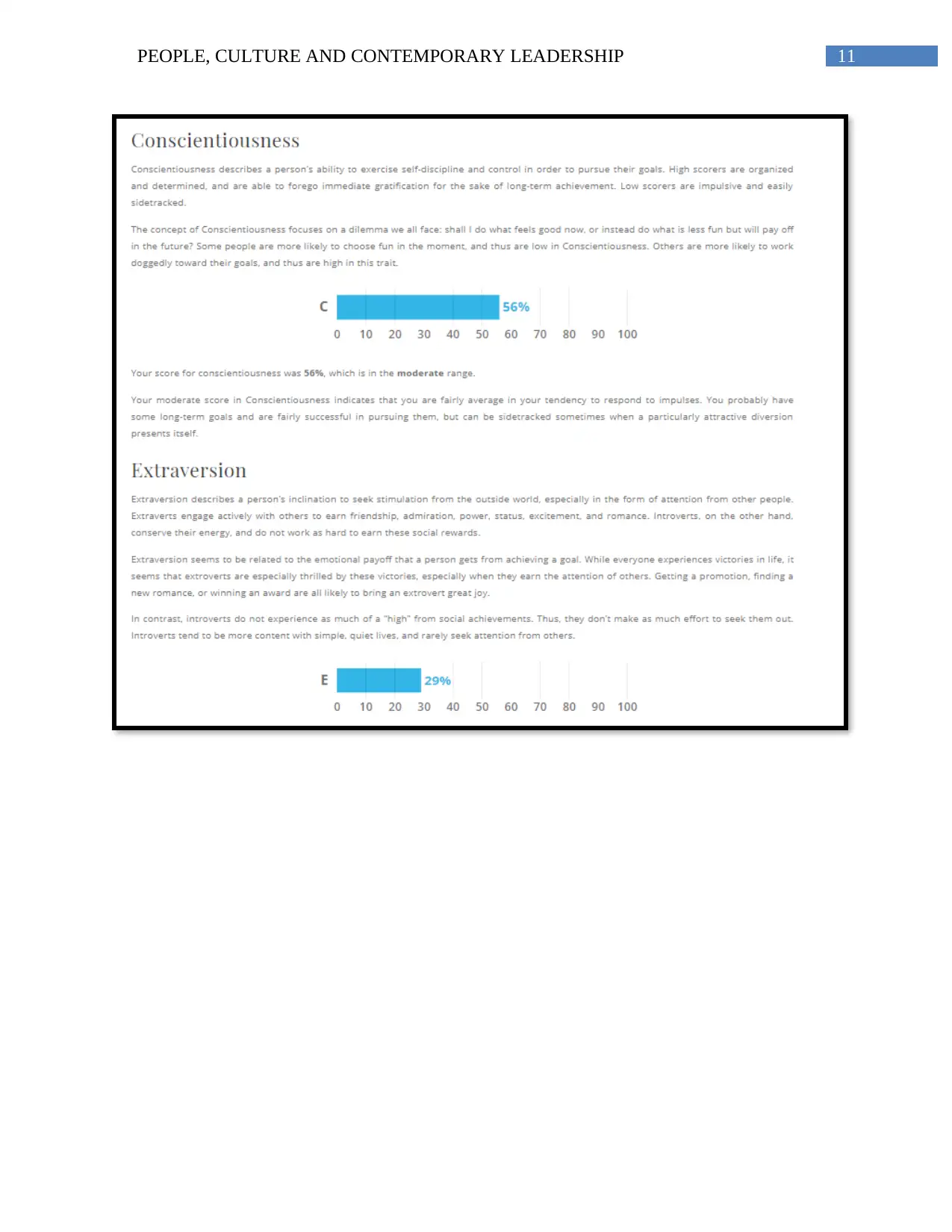
11PEOPLE, CULTURE AND CONTEMPORARY LEADERSHIP
⊘ This is a preview!⊘
Do you want full access?
Subscribe today to unlock all pages.

Trusted by 1+ million students worldwide
1 out of 16
Related Documents
Your All-in-One AI-Powered Toolkit for Academic Success.
+13062052269
info@desklib.com
Available 24*7 on WhatsApp / Email
![[object Object]](/_next/static/media/star-bottom.7253800d.svg)
Unlock your academic potential
Copyright © 2020–2025 A2Z Services. All Rights Reserved. Developed and managed by ZUCOL.




